Ultimate Guide to Planning a Luxury Indian American Wedding – Tips and Costs

A modern luxury Indian-American wedding is a vibrant tapestry woven from ancient rituals, joyous family gatherings, and sophisticated modern style. It’s more than just a ceremony; it’s a grand narrative celebrating cultural heritage across generations. Within the Indian-American community in the US, there’s a beautiful trend towards creating deeply personalized wedding experiences – ones that honor rich traditions while embracing the elegance and possibilities of a luxury American celebration. These events often span several days, each filled with profound meaning and exuberant joy.
This guide is your comprehensive blueprint for planning an unforgettable luxury Indian-American wedding in the USA. Drawing on extensive insights, we’ll walk you through every intricate step: from shaping your initial vision to the final, magical moments of your celebration. We’ll cover budget strategies, vendor selection, integrating time-honored ceremonies, and navigating US-specific logistics and regulations.
Our goal? To help you craft a celebration that is not only breathtakingly luxurious but also a true reflection of your unique love story and cultural identity.
- Defining Your Vision: The Heart of Your Luxury Indian-American Wedding
- Laying the Foundation: Budget, Guest List, and Venue
- Building Your Dream Team: Choosing Culturally Savvy Vendors
- Weaving Tradition & Splendor: Integrating Key Ceremonies
- Elevating the Experience: Creating “Unforgettable” Moments
- The Art of Luxury: Showcasing Splendor in the Details
- Navigating the Nuances: US Logistics & Regulations
- Flawless Execution: Day-Of Management & Contingency Planning
- Your Dream Wedding Awaits
Defining Your Vision: The Heart of Your Luxury Indian-American Wedding
The Cultural Tapestry: Core Ceremonies & Modern Flair
An Indian-American wedding celebration beautifully unfolds over multiple days, bringing together several key ceremonies. Understanding their significance is the first step:
- Sangeet (Music Night): Held a few days before the wedding, this is an evening bursting with music, dance, and pure joy. It celebrates the union of families and lets everyone mingle in a relaxed, festive atmosphere. Think of it as a pre-wedding party celebrating happiness and showering the couple with blessings.
- Mehendi (Henna Party): Primarily for the bride and female relatives/friends (though often inclusive now!), this happens a day or two prior. Intricate henna designs are applied to the bride’s hands and feet, symbolizing beauty, good luck, and marital bliss. Tradition says the darker the stain, the deeper the love!
- Haldi (Turmeric Ceremony): On the day before or morning of the wedding, family members apply a turmeric paste to the bride and groom. This ritual symbolizes purification, blessings, warding off evil spirits, and gives the couple a radiant glow.
- Baraat (Groom’s Procession): A spectacular sight! The groom makes his grand entrance to the wedding venue, accompanied by dancing and singing family and friends. Often riding a decorated white horse (Ghodi) or arriving in style, it symbolizes his journey to marry his bride and unite the families.
- Mandap (Wedding Canopy): The sacred wedding ceremony takes place under the Mandap, a structure typically with four pillars representing the parents. Beautifully decorated, it usually houses the sacred fire (Agni), around which the couple, parents, and priest perform the core wedding rituals.
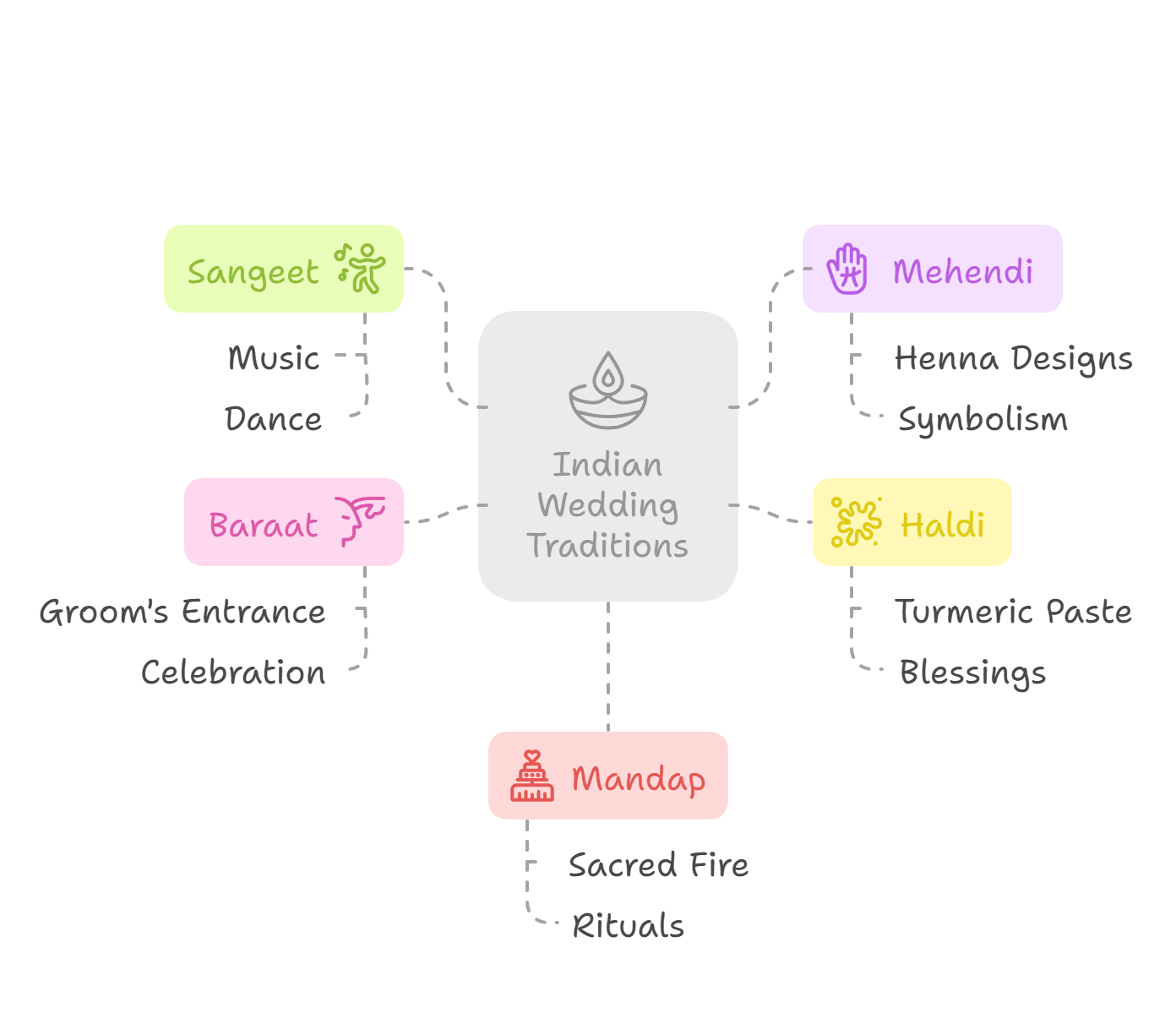
A hallmark of modern Indian-American weddings is the seamless blend of tradition with personal style. Couples are actively weaving their unique love story, values, and personalities into every detail. Perhaps the bride walks down the aisle solo, or the couple makes a fun, choreographed entrance. This reflects the beautiful dual identity of Indian-Americans – respecting roots while celebrating individuality. This requires creative planning and vendors who truly understand this cultural fusion.
Defining Your “Unforgettable” and “Luxury”
What do “luxury” and “unforgettable” mean to you? It’s crucial to define this early on. Luxury could mean:
- Micro-Luxury (Intimate & Exquisite): A trend focusing on a high budget but a smaller guest list (e.g., 50 people). Resources are lavished on top-tier vendors (renowned photographers, designers), exceptional decor, and an unparalleled guest experience.
- Grand Scale Splendor: For many, luxury still involves a large, impressive celebration with hundreds (or even thousands!) of guests.
- Elite Vendors & Service: Hiring the absolute best in the industry – planners, chefs, entertainers, designers.
- Unique Guest Experiences: Offering interactive elements, surprise entertainment, or personalized touches that wow your guests.
- Breathtaking Visuals: Investing heavily in refined decorations, stunning floral arrangements, and sophisticated lighting design.
Defining your luxury vision shapes your budget, guest count, and vendor choices. Also, pinpoint what will make your wedding truly “unforgettable.” Is it a unique theme, a personalized ceremony element, or special memories created for your guests?
Structuring Your Celebration
A typical luxury Indian-American wedding unfolds over several days. A common structure might be:
- Day 1: Mehendi Party / Welcome Dinner
- Day 2: Haldi Ceremony / Sangeet Night
- Day 3: Baraat / Wedding Ceremony / Reception Dinner
Consider the flow and pace of events. Ensure guests have downtime and aren’t rushed. Deciding on all events early is vital, as it impacts budget, venue, and vendor bookings significantly.

Clearly defining your vision, style, and structure is the bedrock of your planning. How will you personalize traditions? What does luxury look like for you? Answering these questions early sets you up for success.
Laying the Foundation: Budget, Guest List, and Venue
Budgeting for Your Luxury Wedding
A luxury Indian-American wedding is a significant investment. Understanding potential costs helps set realistic expectations:
- General Range: While costs vary wildly by location, guest count, and choices, a standard Indian wedding (300 guests) in the US might range from $150k-$225k+. Luxury weddings often start well above $100,000, and for 300 guests, could easily reach $225k – $300k+, sometimes much higher (decor alone can run into hundreds of thousands!).
- Key Cost Drivers: Pre-wedding events (Sangeet is often costly), the reception (usually the most expensive single event), high-end decor/florals, top-tier vendors (planner, photo/video), and designer attire are major budget items.
Estimated Cost Breakdown (Luxury, 300 Guests – For Reference Only)
| Category | Cost Item | Luxury Estimate (USD) | Notes |
|---|---|---|---|
| Pre-Wedding Events | Mehendi, Sangeet, Haldi, etc. | $15,000 – $100,000+ | Sangeet often a major expense. |
| Wedding Ceremony | Venue Rental, Mandap Decor, Priest, Ritual Items | $20,000 – $50,000+ | Mandap decor can be extremely lavish. |
| Reception Dinner | Venue, Catering ($300+/person), Drinks, Cake, Entertainment | $100,000 – $200,000+ | Typically the largest single event cost. |
| Core Vendors | Planner (Full Service) | $10,000 – $30,000+ | Top planners command higher fees. |
| Photo & Video (Top Team, Multi-Day) | $15,000 – $50,000+ | Covers all events, multiple shooters often needed. | |
| Decor & Florals (Overall Design) | $30,000 – $100,000+ | Key to luxury feel; custom structures, abundant florals, lighting. | |
| Attire & Styling | Multiple Outfits (Couple, Family), High-End Jewelry | $20,000 – $75,000+ | Designer wear, custom pieces, multiple changes. |
| Bridal Hair & Makeup (Multi-Day, Top Artist) | $3,000 – $10,000+ | Professional team, on-site services. | |
| Entertainment | DJ, Band, Dhol Drummers, Cultural Performers, Special Acts | $10,000 – $50,000+ | Can include celebrity performers or unique acts. |
| Guest Related | Invitations & Stationery (High-End Custom) | $5,000 – $15,000+ | Custom design, multi-card suites. |
| Guest Accommodation (Coordination/Subsidy) | Variable | Depends on couple’s choice and guest needs. | |
| Guest Transport (Shuttles, etc.) | $5,000 – $15,000+ | Essential for multi-day, multi-location events. | |
| Welcome Bags & Favors (Luxury Custom) | $5,000 – $20,000+ | Reflect luxury and personalization. | |
| Other | Permit Fees (Baraat, Havan), Insurance, Tips | $5,000 – $10,000+ | Varies based on location and requirements. |
| Contingency Fund | (5-10% of Total Budget) | $15,000 – $30,000+ | Crucial for unexpected costs. |
| Total Estimated Range | $250,000 – $600,000+ (Highly dependent on specific choices.) | ||
Disclaimer: These are rough estimates for illustrative purposes. Actual costs can vary significantly.
Your budget dictates guest count and venue, which impacts logistics (accommodation, transport) and vendor needs (catering size, decor scope). Align budget, guest list, and venue early on. Always allocate a 5-10% contingency fund for unforeseen expenses.
Carefully Crafting the Guest List
Indian weddings often mean large guest lists, which can be a challenge with US venue capacities and budgets. Typical US Indian weddings range from 150-500 guests, but micro-weddings (50-100) and grand affairs (1000+) also occur.
Strategies for Managing Your Guest List:
- Categorize: Group guests (core family, close relatives, friends, etc.) to help prioritize.
- Set Clear Rules: Agree with your partner and families on invitation guidelines (plus-ones, kids, distant relatives).
- Consider A/B Lists: Have a ‘B list’ for desired guests if ‘A list’ guests decline (use discretion).
- Factor in Logistics: Account for travel, accommodation (consider hotel blocks), and communication needs for out-of-town guests.
- Use Tools: Spreadsheets or wedding planning software are essential for tracking RSVPs, dietary needs, and contact info for large lists.
Selecting the Grand Stage: Your Venue
Luxury wedding venues need to tick several boxes:
- Capacity & Space: Comfortably host your guest count (often 300+) with multiple distinct spaces (indoor/outdoor) for various events.
- Ambiance & Service: Offer a visually stunning setting that matches your luxury theme and provides high-quality service. Experience with Indian weddings is a huge plus.
- Cultural Compatibility (Crucial!): Confirm their policies before booking:
- Baraat: Is there adequate space? Are horses, elephants, or specific vehicles allowed?
- Havan (Sacred Fire): Is there a designated, safe area (often outdoors, but indoors possible with strict rules)? Do they comply with local fire codes? Some venues explicitly welcome these ceremonies.
- Booking Lead Time: Book 12-24 months in advance for prime venues and dates.
- Venue Trends: Scenic outdoor locations and “blank canvas” venues allowing full personalization are popular.
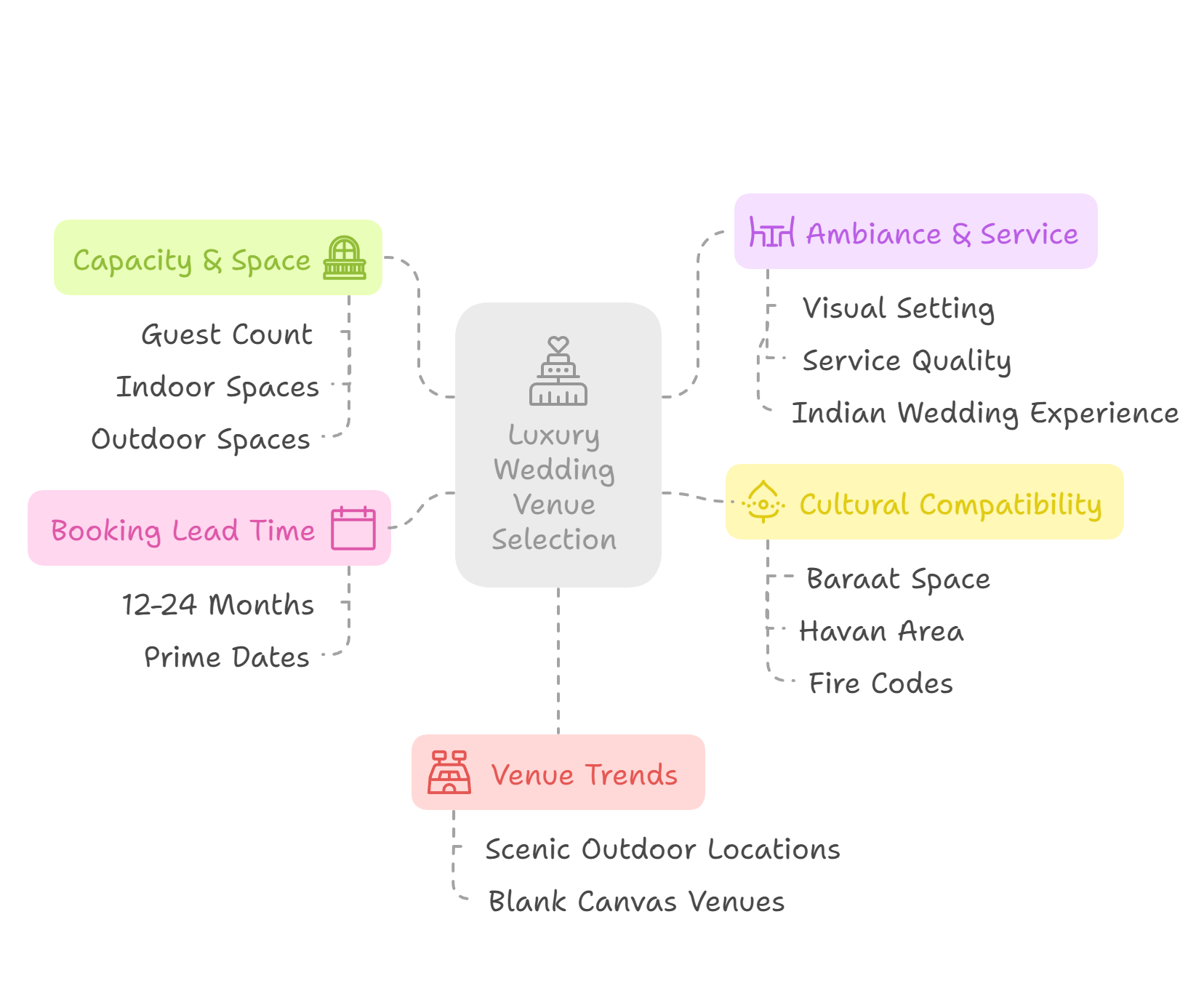
Choosing a venue isn’t just about looks. Thoroughly vet its ability and willingness to host specific cultural elements (Baraat, Havan) legally and practically according to US regulations (permits, fire codes). A beautiful venue that can’t accommodate core traditions is not the right fit.
Building Your Dream Team: Choosing Culturally Savvy Vendors
Why Expertise Matters
The complexity, scale, and cultural nuances of luxury Indian weddings demand experienced vendors. They understand:
- Multi-day event flows and terminology.
- Special requirements (longer hours, multiple setups, ceremony specifics).
- Potential challenges and how to solve them proactively.
- Cultural sensitivity and executing traditions respectfully.
The wedding planner is especially vital. Look for professionals specializing in luxury Indian/South Asian weddings. They bring planning expertise, cultural understanding, and often, a network of trusted, high-quality vendors.
Key Vendor Categories & Considerations
- Wedding Planner: Full-service specialist in luxury Indian/South Asian weddings. Assess detail orientation, cultural fluency, vendor network, multi-day logistics experience.
- Caterer: Skilled in diverse Indian regional cuisines, able to create fusion menus, handle large counts, offer beautiful presentation (e.g., live stations), manage bar service, and possess necessary licenses.
- Decorator/Florist: Proven portfolio of luxury, large-scale designs. Ability to create stunning Mandaps, understand cultural motifs, expertise in lighting.
- Photographer/Videographer: Experience with multi-day Indian weddings, knowledge of key moments, ability to capture energy and color, comprehensive packages.
- Entertainment: High-energy DJ (Bollywood/Bhangra/Pop mix), live band, Dhol drummers (essential for Baraat!), cultural performers.
- Attire/Jewelry: Boutiques or designers offering high-end Indian wedding wear (Lehengas, Sherwanis) and fine jewelry.
- Mehendi Artist: Highly skilled in intricate bridal Mehendi and efficient with guest designs.
- Priest/Officiant: Knowledgeable in specific traditions, ideally able to explain rituals in English for diverse guests.
- Hair/Makeup Artist: Experienced with South Asian features, skilled in long-lasting bridal looks for extended events.
- Transportation: Manages complex multi-day, multi-point guest shuttle logistics and luxury transport for the couple/family.
- Stationery: Designs high-end, culturally relevant invitations and day-of paper goods.
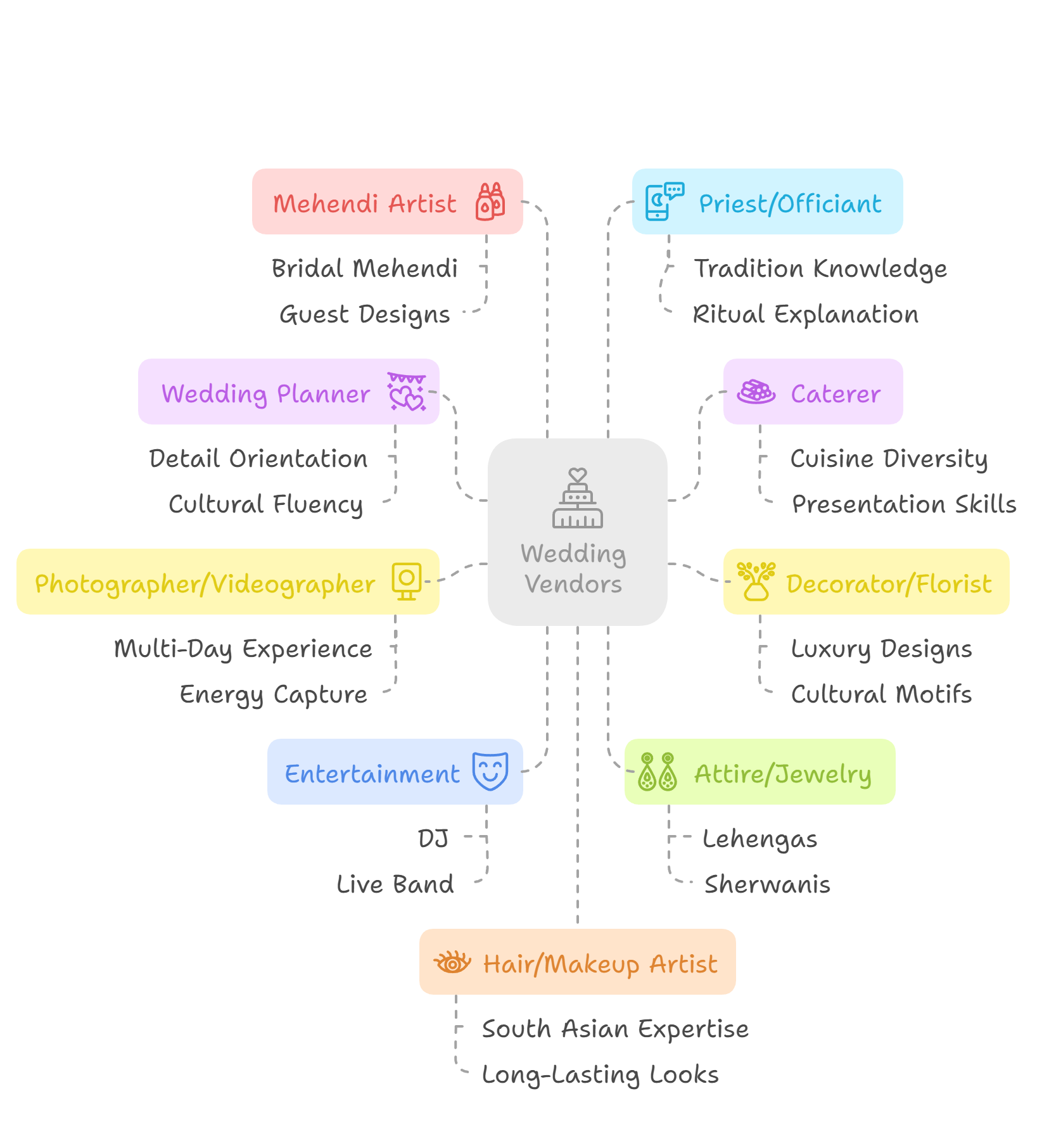
Finding and Vetting Your Team
- Use Reputable Resources: Check trusted platforms like Maharani Weddings’ Platinum Guide or The Knot/WeddingWire (filter for Indian wedding experience).
- Seek Referrals: Ask your planner, venue manager, or recently married friends/family.
- Vet Thoroughly: Review portfolios, read client reviews, conduct in-depth interviews. Ask specific questions about luxury Indian wedding experience, multi-day events, and cultural understanding. Confirm insurance and ask about backup plans.
Selecting vendors is about assembling an expert team with cultural competence and proven ability to handle high-stakes, complex events. Your planner often acts as a crucial “matchmaker,” ensuring the entire team aligns with your vision and standards.
Weaving Tradition & Splendor: Integrating Key Ceremonies
Seamlessly blending cherished traditions into a luxurious modern celebration is an art form.
Elevating Pre-Wedding Celebrations
- Sangeet (Music Night):
- Core Meaning: Joy, music, dance, family bonding.
- Luxury Touches: Go beyond simple performances. Introduce themes, interactive games (family dance-offs, fun awards), professional acts (Qawwali singers, Bollywood troupes), elaborate stage design, themed decor, sophisticated food/drink stations, comfy dancing slippers for guests.
- Logistics: Usually 1-3 nights before, one evening. Schedule flow logically (welcome, performances, dinner, open dance).
- Attire: Encourage colorful, festive Indian wear.
- Mehendi (Henna Party):
- Core Meaning: Beauty, blessings, good fortune for the bride.
- Luxury Touches: Hire top Mehendi artists for the bride’s intricate design (can take hours!). Set up stylish stations for guests with skilled artists offering quicker designs. Create a relaxed, chic lounge vibe with music, food, and comfy seating.
- Logistics: Typically 1-4 days before, lasts several hours. Traditionally female-focused but often includes all guests now.
- Attire: Bright colors that allow henna to be shown off (green, yellow, pink are popular).
- Haldi (Turmeric Ceremony):
- Core Meaning: Purification, blessings, good luck, pre-wedding glow.
- Luxury Touches: Enhance the atmosphere with elegant decor (often yellow-themed with marigolds), encourage guest attire (yellow!), provide background music, offer chic snacks/drinks. Keep the vibe joyful and intimate.
- Logistics: Usually day before or morning of the wedding. Ceremony itself is short.
The Grand Journey of the Wedding Day
- Baraat (Groom’s Procession):
- Core Meaning: Groom’s journey to marry the bride, uniting families.
- Luxury Touches: Make it a visual and auditory spectacle! Groom arrives on a decorated horse (Ghodi), elephant, luxury car, vintage vehicle, etc. Hire professional Dhol drummers, a live band, or DJ for high energy. Coordinate Baraati outfits. Add effects like colored smoke or petal showers.
- Key Rituals: Includes Milni (family greetings), Aarti (mother blesses groom), Jaimala/Varmala (garland exchange).
- Logistics: Coordinate route/space with venue. May require city permits (see Logistics section below).
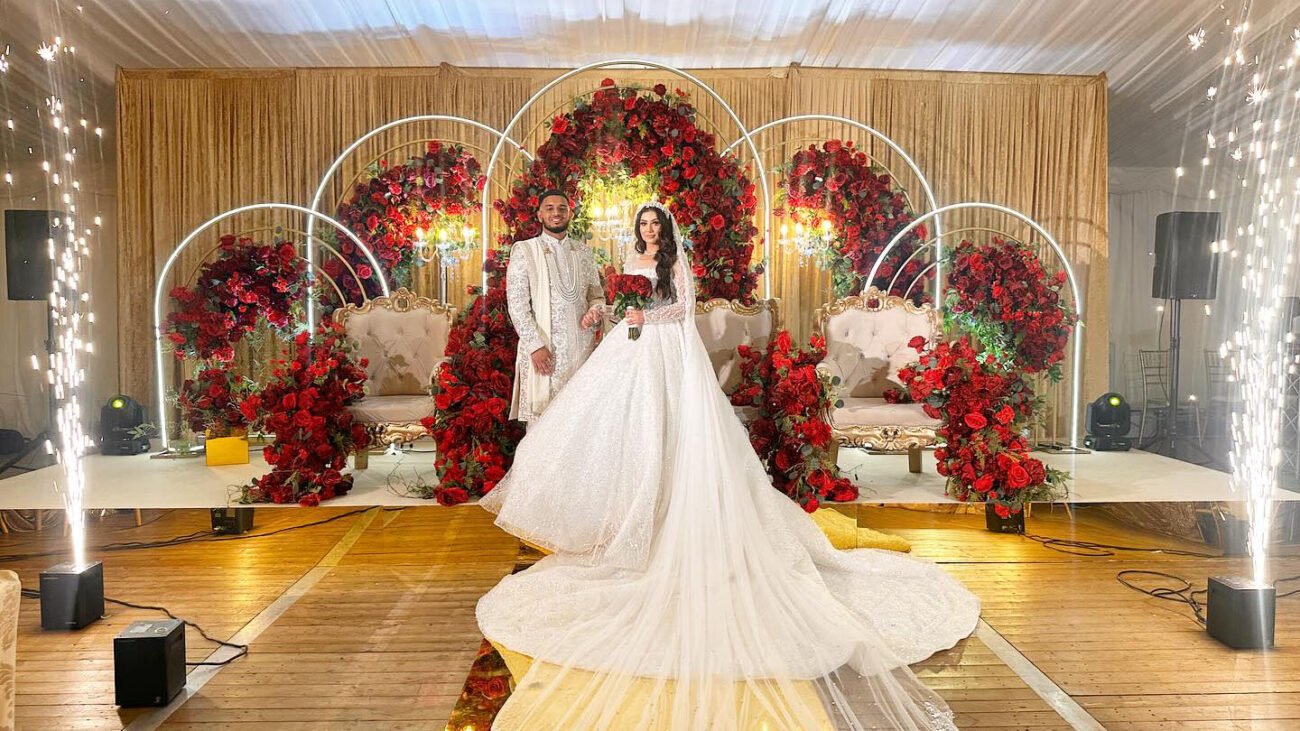
- Mandap Ceremony (Wedding Canopy):
- Core Meaning: Sacred space for the wedding, symbolizing universe and family protection.
- Luxury Touches: The Mandap is a major decor statement. Use luxury materials (crystal, silk), elaborate floral designs (cascading florals, flower walls), dramatic lighting, custom structures. Inside houses the sacred fire (Agni/Havan Kund).
- Ceremony Flow: Led by the priest, includes key rituals like Kanyadaan (giving away the bride), Mangalsutra tying, Saptapadi (seven steps/vows around the fire).
- Logistics: Ensure enough space, seating, and adherence to fire safety if Havan is involved (see Logistics section).
Creative Fusion Elements
Blending Eastern and Western traditions creates a unique experience:
- Ceremony Fusion: Incorporate American-style vows alongside Hindu pheras, or a unity candle ceremony with the Mangalsutra ritual. Hold a Western-style reception after the Indian ceremony.
- Attire Fusion: Bride wears a Lehenga for ceremony, changes into a gown for reception. Groom wears a Sherwani, then a tuxedo. Consider fusion designs.
- Catering Fusion: Offer dishes blending Indian and Western flavors, or diverse stations (Indo-Chinese, Mexican-Indian).
- Music Fusion: Hire a DJ/band skilled in mixing Bollywood, Bhangra, and Western hits seamlessly.
Success lies in open communication with families, respecting key traditions, and finding a balance that feels authentic to you as a couple. Integrating these ceremonies requires meticulous timelines, smart venue usage, coordinated vendors, and clear guest communication.
Elevating the Experience: Creating “Unforgettable” Moments
A truly unforgettable luxury wedding goes beyond rituals and aesthetics; it’s about creating unique, heartfelt moments.
Personalization is Paramount
Weave your story into the celebration:
- Custom Stationery: Invitations telling your story through illustrations or unique wording.
- Theme Integration: Design around a shared passion or cultural element (e.g., “Bollywood Glam,” “Jaipur Garden”).
- Personalized Welcome Gifts: Bags with your favorite local treats, custom items reflecting the theme, or thoughtful notes.
- Storytelling Elements: Share your journey through decor details, ceremony explanations, or a personalized welcome speech.
Entertainment That Wows
Think beyond the expected:
- Surprise Acts: Close-up magicians, professional Bollywood or fusion dance troupes, live event painters, dramatic fire dancers.
- Modern Spectacles: Drone light shows (for outdoor venues) creating patterns or initials in the sky.
- Interactive Fun: Well-organized games (custom Bingo, Shoe Game, giant Jenga), engaging photo booths (anti-gravity, slow-mo).
Memorable Entrances
Make a statement beyond the Baraat:
- Bride’s Entrance: Choreographed dance with bridesmaids, escorted by special family members, or a powerful solo walk.
- Reception Entrance: Dramatic couple’s entry with coordinated lighting, music, and special effects (cold sparks, fog).
Exceptional Guest Care
Make every guest feel cherished:
- Interactive Food & Drink: Live Chaat stations, custom cocktail bars, diverse fusion food experiences.
- Unique Memory Makers: Creative photo/video booths, live social media walls.
- Thoughtful Details: Comfort stations (shawls, fans, refreshments), clear signage, convenient transport, welcome bags with schedules and local tips, on-site Mehendi artists for guests.
Creating “unforgettable” means combining high-impact elements with deep personalization and cultural relevance. It’s about delighting the senses and making guests feel valued.
The Art of Luxury: Showcasing Splendor in the Details
Luxury is felt in the quality, craftsmanship, and meticulous attention to every detail.
Exquisite Decor and Ambiance
- Mandap & Stage Design: The visual centerpiece. Think opulent materials (crystal, lush silks), intricate floral designs (hanging installations, flower walls), dramatic lighting (chandeliers, pin spotting), and custom structures. Aim for wow-factor!
- Table Settings: Layered luxury. Use rich linens (velvet, satin), metallic chargers, fine crystal, striking centerpieces (candelabras, lush florals, or a mix).
- Lighting Design: Crucial for mood. Use uplighting for ambiance, pin spotting for highlights, chandeliers for drama, maybe even a candle wall for romance.
- Floral Design: Abundance and quality. Unique installations like floral chandeliers, arches, or runners make a huge impact.
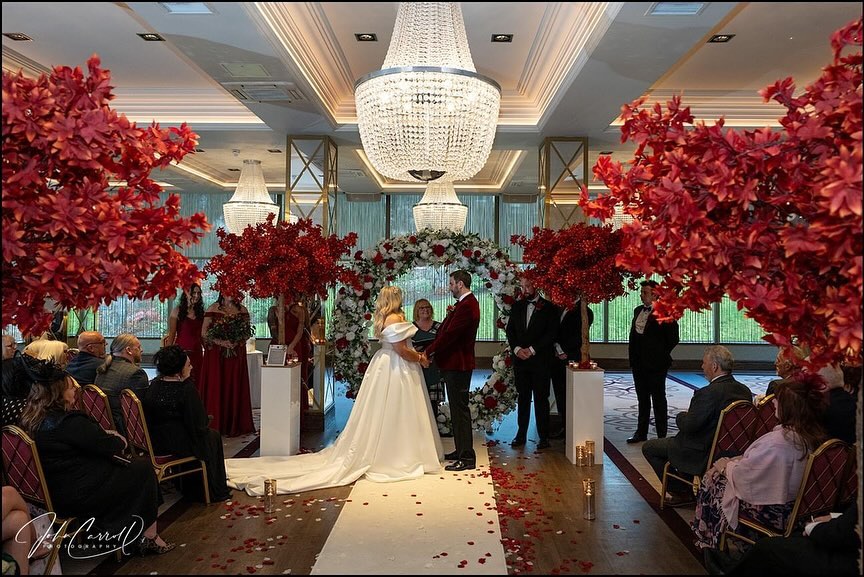
Top-Tier Culinary Experience
- Custom Menus: Work with high-end caterers for bespoke menus featuring authentic Indian flavors, creative fusion dishes, and options for diverse palates.
- Artful Presentation: Focus on beautiful plating, eye-catching live cooking stations, and themed food displays using top-quality ingredients.
- Premium Bar Service: Offer high-quality spirits, wines, champagne. Design signature cocktails. Consider a stylish custom bar structure.
Designer Attire and Dazzling Jewelry
- Brands & Customization: Source from top Indian designers or high-end boutiques. Consider custom-made outfits for a unique look.
- Craftsmanship: Emphasize exquisite hand embroidery, beadwork, and luxurious fabrics (silk, velvet).
- Jewelry: High-end traditional (Polki, Kundan) or modern diamond/gemstone pieces that complement the outfits.
- Multiple Looks: Plan distinct, stunning outfits for each event day.
Impeccable Guest Service
- “White Glove” Approach: Aim for seamless, attentive service where guest needs are anticipated.
- Dedicated Support: Consider a guest concierge or dedicated team for assistance.
- Comfort is Key: Elegant lounge areas, thoughtful amenities (pashminas for cool evenings, fans for heat), easy navigation.
True luxury is a symphony of sensory experiences – stunning visuals, delicious tastes, captivating sounds, luxurious textures, all delivered with flawless service.
Navigating the Nuances: US Logistics & Regulations
Planning in the US means blending culture with local rules. Ignoring these can cause major issues.
Coordinating Your Vendor Team
Managing numerous vendors across multiple days/locations is complex. Your wedding planner is the central hub, creating detailed timelines, managing communication, ensuring smooth transitions, and troubleshooting. Choose communicative, experienced vendors.
Managing Guest Logistics
Crucial for multi-day events with out-of-town guests:
- Accommodation: Book hotel room blocks near venues well in advance. Offer options at different price points. Communicate details clearly.
- Transportation: Arrange airport transfers, shuttle services between hotels and venues, and cars for the couple/family. Provide clear schedules and pickup points. Factor in traffic!
- Information: Provide welcome bags/packets with detailed schedules, maps, contacts, local info. Ensure clarity and consistency.
US-Specific Permits and Regulations (Essential!)
Many Indian wedding traditions intersect with local US laws. Always check regulations in your specific city/county/state.
- Baraat Procession:
- Permit Likely Needed: If using public streets, involving animals (horse, elephant), or having loud amplified music (band, Dhol). Apply well in advance to the local city/county government. Requirements vary greatly.
- Animal Rentals: Ensure vendors have proper licenses and liability insurance.
- Havan (Sacred Fire Ceremony):
- Venue Policy is Key: Confirm if open flames are allowed and their specific rules before booking. Many venues have strict limits or bans, especially indoors.
- Fire Safety: Strict adherence to fire codes is mandatory. Requires designated fire-safe area, proper container (Havan Kund), fire extinguishers, possibly a fire watch professional.
- Outdoor Restrictions: Outdoor fires can be restricted during dry seasons or burn bans.
- Venue Compliance: Ensure the venue meets fire safety standards (alarms, sprinklers, exits).
- Alcohol Licensing:
- General Rule: For private, invite-only events where alcohol is free (open bar) and not sold, the hosts usually don’t need a license.
- Best Practice: Use a venue with its own liquor license OR hire a licensed and insured catering/bartending service. This shifts liability.
- License Needed If: You sell alcohol (cash bar), charge for entry where alcohol is served, or serve in an unlicensed public space.
- State/Local Rules Vary: Rules differ significantly by state and even county (“dry” vs. “wet”). Verify your specific location’s laws.
- Noise Ordinances:
- Common Limits: Most US cities have noise ordinances limiting volume, especially late at night (e.g., after 10 or 11 PM), particularly impacting outdoor events or venues near homes.
- Impact: Affects late-night Sangeets or Receptions.
- Strategies: Know local rules/curfew; choose venues wisely (isolated or soundproofed); schedule loud music earlier; hire sound engineers; communicate with neighbors; consider “silent disco” headphones for late-night dancing.
The Importance of Insurance
- Event Liability Insurance: Essential. Covers property damage or personal injury. Many venues require it.
- Liquor Liability Coverage: Needed if serving alcohol (often included if using a licensed caterer/bartender).
Planning in the US requires navigating a regulated environment. Proactive compliance is crucial to avoid fines, shutdowns, or legal issues. Efficient guest logistics are fundamental to the luxury experience.
Flawless Execution: Day-Of Management & Contingency Planning
Great planning needs great execution, especially for complex, multi-day luxury events.
Master the Timeline
- Create hyper-detailed timelines (minute-by-minute) for each event day.
- Distribute finalized timelines to all vendors, key family, and wedding party.
- Build in buffer time for potential delays (traffic, photos, outfit changes).
The Power of On-Site Coordination
- A professional wedding planner or day-of coordinator is invaluable. They oversee setup, guide the flow, manage vendors, handle guests, and solve problems discreetly.
- This frees you and your families to relax and fully experience the celebration.
Contingency Planning (“Plan B”) is Non-Negotiable
Expect the unexpected and have backups ready:
- Weather: Have a solid backup indoor space or high-quality tent for outdoor events. Monitor forecasts.
- Vendor Issues: Confirm vendors have backups. Have contracts specifying alternatives. Keep a list of emergency contacts.
- Attire Mishaps: Pack a wedding emergency kit (see below). Have backup outfits (e.g., simple Kurta for groom). Know local tailors.
- Logistical Failures: Backup transport options. Venue backup generator? Alternate routes for traffic?
- Guest Issues: Discuss sensitive situations (family dynamics, unexpected guests) with your planner beforehand for discreet handling.
Your Wedding Emergency Kit
Pack a kit and give it to a trusted bridesmaid or planner:
- Sewing kit, safety pins, fashion tape
- Stain remover pen/wipes
- Basic meds (pain relievers, antacids, bandages)
- Makeup touch-up items (lipstick, powder, swabs)
- Hairspray, bobby pins, comb
- Mints/breath spray
- Small snacks, water
- Phone power bank
- List of key contacts (vendors, family)
Final Preparations
- Payments & Tips: Prepare final payments/tips in labeled envelopes beforehand. Assign someone trusted (planner, best man) to distribute.
- Item Handover: Give favors, place cards, guest book, ceremony items to your planner/venue coordinator in advance with clear instructions.
- Delegate Wrap-Up: Assign someone to collect gifts, personal items, and handle rental returns after the event.
Simplified Wedding Planning Timeline & Checklist
| Timeline | Key Tasks |
|---|---|
| 12+ Months Out | Set date, estimate budget & guest count, define events, research/hire planner (optional), research venues. |
| 8-12 Months Out | Book venue, finalize guest list size, select wedding party, choose theme/colors, send Save-the-Dates, build website, research core vendors (caterer, decor, photo). |
| 6-8 Months Out | Book core vendors, book Baraat transport, start attire shopping. |
| 4-6 Months Out | Book hair/makeup (do trials!), book Mehendi artist, finalize cake, arrange guest accommodations (hotel blocks), buy rings, order invitations. |
| 2-4 Months Out | Mail invitations, buy accessories, finalize menu/decor, plan/book honeymoon, get marriage license info. |
| 1-2 Months Out | Track RSVPs, finalize guest count, buy favors, finalize bar service, prepare programs, confirm details with vendors, final attire fittings. |
| 2-3 Weeks Out | Give final counts to vendors, create seating chart, write vows/toasts, confirm payments, distribute final timeline. |
| Week Of | Hand off items to coordinator, pack emergency kit & honeymoon bags, confirm weather plan, final beauty tasks, attend rehearsal. |
| Wedding Day(s)! | Relax, trust your team, and soak in every moment! |
| Post-Wedding | Ensure vendors paid, preserve attire, send Thank You cards (within ~8 weeks), handle name change (if applicable). |
For complex luxury Indian weddings, contingency planning is essential, not optional. Effective delegation and trusting your professional team are key to smooth execution and your own enjoyment.
Your Dream Wedding Awaits
Planning a luxury Indian-American wedding is a journey – intricate, demanding, but incredibly rewarding. It’s about weaving together cultural richness, family love, and modern elegance. From defining your vision and budget, to building your expert team, integrating sacred ceremonies, navigating US logistics, and ensuring flawless execution, every step matters.
Key Takeaways for Success:
- Plan Proactively & Detail-Oriented: Start early, be meticulous.
- Embrace Exquisite Details: Luxury shines in the quality of decor, food, attire, and service.
- Build an Expert, Culturally Fluent Team: Choose vendors who understand your vision and traditions.
- Find Your Unique Balance: Respect tradition while boldly incorporating your personal style and modern elements.
We hope this guide provides clarity and confidence as you embark on this exciting planning process. Remember to embrace the journey – it’s part of creating lifelong memories. Trust your vision, rely on your team, and get ready to celebrate a dream wedding that is both stunningly luxurious and deeply, authentically you.
